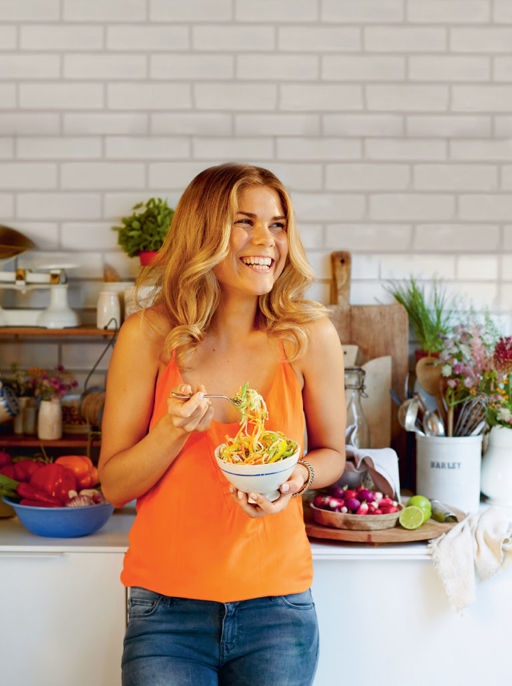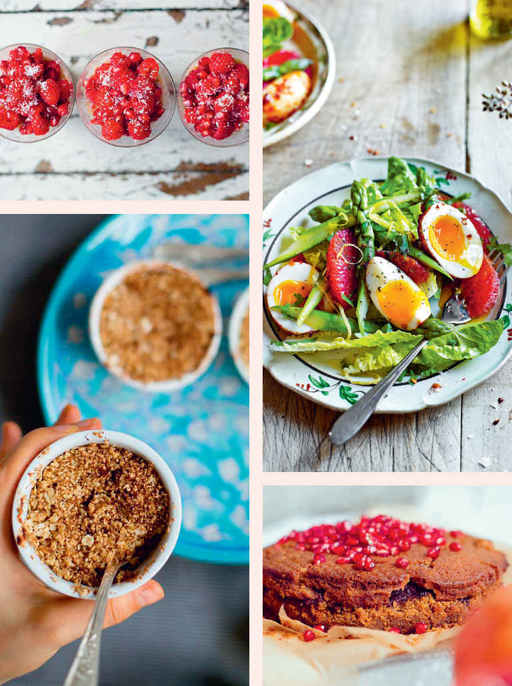Get the Glow (7 page)
Authors: Madeleine Shaw

soak, stroke and sleep away the stress
A great way to reduce stress is to have a soak in a delicious warm Epsom salt bath. Epsom salts help relax the muscles and ease you into a good night’s sleep. Just pour 1 cup of Epsom salts into a bath and soak in the tub for 15 minutes. This is great for recovering post-workout, too, as it eases tired muscles.
I also love dry brushing before getting into a bath or shower; it’s the best way to get rid of stubborn areas of cellulite and to eliminate toxic build-up from the body. So since we’ve ditched the junk from our diet, it’s time to brush it out of the system too.
how to dry brush
Grab a natural bristle brush. Before you hop in the shower brush it over your bare skin, starting from your toes and moving towards your head. Brush in an upward sweeping motion (be careful around sensitive areas), and give that butt a good go too.
benefits of dry body brushing
• Improves muscle tone
• Evens out fat deposits
• Regulates body temperature
• Stimulates hormones and oil-producing glands, making your skin glow
• Blasts cellulite
sleep sweetly
Sleep is key to a healthy body. It helps banish sugar cravings, reduces hunger and banishes stress. Aim to sleep from 10pm to 6am – this is the best time to be in bed to allow your body to restore itself. Here are some tips on how to have a good night’s sleep:
• Don’t eat after 8.30pm and get in bed for 10pm.
• Have a small chamomile tea before bed.
• Limit alcohol.
• Wind down and de-stress before bed.
• Avoid any screen time before bed; try reading instead.
• Make your room dark and cold with cosy bedding.
Q&A
Q: I struggle with portion control – how can I combat overeating?
A: Mindfulness is the key to overcoming this. Slow down, chew your food and you’ll soon find you won’t be reaching for more. As a general rule, per meal I would aim for a fist-size of protein, the same for grains or starchy veg, and then an unlimited amount of non-starchy veg. Try and eat one big plateful and then not have any more.
When you serve yourself, try not to have lots of extras lying around on the table. Imagine you’re eating in a restaurant – you’d never ask for a second helping when eating out!
Q: What time should I eat in the evening?
A: The timing of food does matter; it’s best to eat your biggest meal for lunch and a lighter one for dinner, as your digestive fire burns much lower in the evening. Aim to eat before 8pm so your food is properly digested before you hit the hay.
Q: I’m feeling run-down – what should I take?
A: Boost your immune system with this little concoction. Boil the kettle and pour the water into a mug. Crush in 1 garlic clove, add 1 tablespoon honey, 1 tablespoon freshly grated ginger and ½ teaspoon whole cloves, then let it sit for 5 minutes and drink. Repeat three times a day.

LIVE
your
GLOW
week six

Congratulations – you are in your final week! Now it’s time to set you up with healthy habits to ensure you live your glow . . . for life.
post-programme binge
Now you are nearing the end, it doesn’t mean you can swerve back to your old ways and overindulge on sugar and bad carbs. I’m not saying you can’t ever have these naughty treats, but you should eat consciously and because you love it, not as an act of anger, sadness or boredom.
I think the best time to eat something naughty is when you’re out to dinner.
Why?
Well, unless you are at a buffet there is only one piece of pie: when it’s gone, it’s gone. The restaurant setting makes you savour the taste and enjoy the experience so much more than you would a giant tub of vanilla ice cream while sitting on your sofa.
a word about sabotage . . .
You may have noticed a few pesky friends or colleagues trying to lead you astray over the past 6 weeks, tempting you with cake or big nights out.
This is totally normal and to be expected. Sometimes people see others changing around them and they feel threatened, so they try to sabotage your decisions.
Be aware of this, and use the tools you’ve learned over the past 6 weeks – being mindful of what you’re eating, and your reasons for embarking on this programme in the first place.
avoid the snack-trap
And of course, we’re often our own saboteur. We’ve all been there – we’ve eaten healthily all day but have blown it
by snacking on treats the moment we’re home. Stop this by:
• having a big cup of herbal tea as soon as you’re through the door
• spending the evening with friends
• staying out of the kitchen and not opening the fridge door
• having a green juice – it’s packed full of nutrients to satisfy your cravings
• eating a proper lunch – so many people don’t eat enough for this crucial meal
• drinking a glass of water – that rumble in your stomach might be because you’re thirsty.
Snacking constantly is very taxing for your digestive system; leave gaps between your meals so your body can rest and digest.
running low on the glow?
It could be that you’re falling into the snack trap because you’re running low on energy. Avoid the slump with the following energy-boosting foods:
•
Freshly grated ginger:
A great stimulator to throw into smoothies, or whack it in a stir-fry.
•
Sweet potatoes:
A great carb to have; one serving brings total vitality to the day.
•
Nuts and seeds:
Walnuts contain the most omega-3s of all the nuts, and are great for brain power.
•
Eggs:
Bursting with protein, these babies will keep you full and energised all day long.
•
Quinoa:
This grain is a great source of vegetarian protein. It packs a punch with a nice dose of folate, magnesium and phosphorus.
how to read food labels
• Choose foods with the fewest ingredients on the label.
• If it contains added sugar – bin it.
• Avoid any ‘diet’, ‘low-fat’ and ‘0% fat’ labels.
• Only eat foods that contain words you understand – no crazy E numbers, please!
• Choose savoury foods that contain less than 6g of sugar per 100g.
should i go organic?
The way we farm and manufacture our food has changed. We import lots of our food from the other side of the world, and the manufacturers tend to load it with pesticides and preservatives.
However, I understand that buying organic often comes with a heftier price
tag. I don’t buy organic produce all the time, but certain fruit and veg are best bought organic, because more pesticides and chemicals are typically used in their production. I have therefore divided some common fruit and veg into the ‘dirty dozen’ and the ‘clean fifteen’.
| the dirty dozen: buy these organic | the clean fifteen: no need to buy these organic |
| apples | onions |
| celery | sweetcorn |
| peppers | pineapples |
| pears | avocado |
| strawberries | cabbage |
| grapes | peas |
| spinach | asparagus |
| lettuce | mangoes |
| cucumbers | aubergine |
| potatoes | kiwi |
| green beans | melon |
| kale | sweet potatoes |
| | grapefruit |
| | watermelon |
| | mushrooms |
shop local
Choosing organic is the best option, but I think it’s even more important to buy food that is grown locally. Much of the food we eat is grown thousands of miles away, meaning it takes longer to hit your dinner plate, during which time it loses nutrition and taste – not to mention polluting our beautiful planet to get there.
Locally bought food tastes fresh, can often work out cheaper and is good for the conscience.
how to eat local
• Do your weekly shop at a farmers’ market.
• Get a local veg box delivery.
• Chose local produce over foreign.
• Eat seasonal produce; you can look up what’s in season online.
super chef
Don’t panic too much when it comes to cooking your food. The key is to use the right oils and not overdo the dish. Methods to avoid:
• Microwaving
• Over-boiling
• Burning (glycation) – burnt food can cause toxic build-up
•
Deep frying
Instead, stick to:
• Boiling or steaming in a little water, keeping the crunch
• Grilling, roasting, baking or sautéing
Try cooking in coconut oil or butter; they both have high smoking points and do not denature in heat. Do not burn, though! Olive oil is OK for cooking at low temperatures or drizzling over at the end.
cook it slow and low
I have a total love affair with my slow cooker. It’s the easiest way to get a good nourishing meal inside you. If you aren’t much of a cook, it will be your best friend. All you have to do is pop a whole load of veg and meat in it, and – hey presto! – a restaurant-worthy dish appears. Often I’ll leave mine on during the day while I’m out and about, and when I get home I’ll open the door to a ready-made dinner.
They’re cheap, they make meat melt of the bone . . . and it’s only one pot to clean up at the end of a long day. Get into the habit of making a slow roast on a Sunday and eating the meat all week.
The best part about slow cooking is that you can use cheaper, less-popular cuts of meat like brisket, shoulder and neck. The slow cooker totally transforms these generally tougher cuts into delicacies. Also, cooking slow and low retains more nutrients (those that are destroyed from the heat) for the body.
Other books
The Night Everything Changed by Kristopher Rufty
Bringing Home an Alien by Jennifer Scocum
Supernatural: One Year Gone by Dessertine, Rebecca
Crimson Vengeance by Wohl, Sheri Lewis
With Every Breath by Elizabeth Camden
The Knight of Spurs and Spirits by Terry Deary
Wild Roses by Deb Caletti
A Comedy of Heirs by Rett MacPherson
Historical Romance Boxed Set by Novak, Brenda
Passion & Pumpkins by Lily Rede
